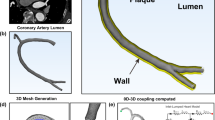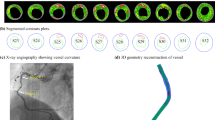Abstract
The measurement of fractional flow reserve (FFR) and superficial wall stress (SWS) identifies inducible myocardial ischemia and plaque vulnerability, respectively. A simultaneous evaluation of both FFR and SWS is still lacking, while it may have a major impact on therapy. A new computational model of one-way fluid–structure interaction (FSI) was implemented and used to perform a total of 54 analyses in virtual coronary lesion models, based on plaque compositions, arterial remodeling patterns, and stenosis morphologies under physiological conditions. Due to a greater lumen dilation and more induced strain, FFR in the lipid-rich lesions (0.81 ± 0.15) was higher than that in fibrous lesions (0.79 ± 0.16, P = 0.001) and calcified lesions (0.79 ± 0.16, P = 0.001). Four types of lesions were further defined, based on the combination of cutoff values for FFR (0.80) and maximum relative SWS (30 kPa): The level of risk increased from (1) plaques with mild-to-moderate stenosis but negative remodeling for lipid-rich (Type A: non-ischemic, stable) to (2) lipid-rich plaques with mild-to-moderate stenosis and without-to-positive remodeling (Type B: non-ischemic, unstable) or plaques with severe stenosis but negative remodeling for lipid-rich (Type C: ischemic, stable) to (3) lipid-rich plaques with severe stenosis and without-to-positive remodeling (Type D: ischemic, unstable). The analysis of FSI to simultaneously evaluate inducible myocardial ischemia and plaque stability may be useful to identify coronary lesions at a high risk and to ultimately optimize treatment. Further research is warranted to assess whether a more aggressive treatment may improve the prognosis of patients with non-ischemic, intermediate, and unstable lesions.





Similar content being viewed by others
Abbreviations
- CFD:
-
Computational fluid dynamics
- DS%:
-
Percent diameter stenosis
- FEA:
-
Finite element analysis
- FFR:
-
Fractional flow reserve
- FSI:
-
Fluid–structure interaction
- MLD:
-
Minimum lumen diameter
- rSWS:
-
Relative superficial wall stress
References
Taylor CA, Fonte TA, Min JK (2013) Computational fluid dynamics applied to cardiac computed tomography for noninvasive quantification of fractional flow reserve: scientific basis. J Am Coll Cardiol 61(22):2233–2241
Van De Hoef TP, Meuwissen M, Escaned J, Davies JE, Siebes M, Spaan JAE, Piek JJ (2013) Fractional flow reserve as a surrogate for inducible myocardial ischaemia. Nat Rev Cardiol 7(8):439–452
Pijls NHJ, Tanaka N, Fearon WF (2013) Functional assessment of coronary stenoses: can we live without it? Eur Heart J 34(18):1335–1344
Itu L, Rapaka S, Passerini T, Georgescu B, Schwemmer C, Schoebinger M, Flohr T, Sharma P, Comaniciu D (2016) A machine-learning approach for computation of fractional flow reserve from coronary computed tomography. J Appl Physiol 121(1):42–52
Tu S, Barbato E, Köszegi Z, Yang J, Sun Z, Holm NR, Tar B, Li Y, Rusinaru D, Wijns W, Reiber JHC (2014) Fractional flow reserve calculation from 3-dimensional quantitative coronary angiography and TIMI frame count. JACC Cardiovasc Interv 7(7):768–777
Wu X, von Birgelen C, Li Z, Zhang S, Huang J, Liang F, Li Y, Wijns W, Tu S (2018) Assessment of superficial coronary vessel wall deformation and stress: validation of in silico models and human coronary arteries in vivo. Int J Cardiovasc Imaging 34(2):1–13
Kwak BR, Baeck M, Bochaton-Piallat M-L, Caligiuri G, Daemens MJAP, Davies PF, Hoefer IE, Holvoet P, Jo H, Krams R, Lehoux S, Monaco C, Steffens S, Virmani R, Weber C, Wentzel JJ, Evans PC (2014) Biomechanical factors in atherosclerosis: mechanisms and clinical implications. Eur Heart J 35(43):3013–3020
Ohayon J, Finet G, Le Floc’h S, Cloutier G, Gharib AM, Heroux J, Pettigrew RI (2014) Biomechanics of atherosclerotic coronary plaque: site, stability and in vivo elasticity modeling. Ann Biomed Eng 42(2):269–279
Brown AJ, Teng Z, Calvert PA, Rajani NK, Hennessy O, Nerlekar N, Obaid DR, Costopoulos C, Huang Y, Hoole SP, Goddard M, West NEJ, Gillard JH, Bennett MR (2016) Plaque structural stress estimations improve prediction of future major adverse cardiovascular events after intracoronary imaging. Circ Cardiovasc Imaging 9(6):e004172
Holzapfela GA, Mulvihillb JJ, Cunnaneb EM, Walshb MT (2014) Computational approaches for analyzing the mechanics of atherosclerotic plaques: a review. J Biomech 47(4):859–869
Akyildiz AC, Speelman L, Gijsen FJH (2014) Mechanical properties of human atherosclerotic intima tissue. J Biomech 47(4):773–783
Thondapu V, Bourantas CV, Foin N, Jang I-K, Serruys PW, Barlis P (2016) Biomechanical stress in coronary atherosclerosis: emerging insights from computational modelling. Eur Heart J 38(2):81–92
Wu X, von Birgelen C, Muramatsu T, Li Y, Holm NR, Reiber JHC, Tu S (2017) A novel four-dimensional angiographic approach to assess dynamic superficial wall stress of coronary arteries in vivo: initial experience in evaluating vessel sites with subsequent plaque rupture. EuroIntervention 13(9):1099–1103
Kock SA, Nygaard JV, Eldrup N, Fründ E-T, Klærke A, Paaske WP, Falk E, Kim WY (2008) Mechanical stresses in carotid plaques using MRI-based fluid-structure interaction models. J Biomech 41(8):1651–1658
Teng Zhongzhao, Canton Gador, Yuan Chun, Ferguson Marina, Yang Chun, Huang Xueying, Zheng Jie, Woodard Pamela K, Tang Dalin (2010) 3D critical plaque wall stress is a better predictor of carotid plaque rupture sites than flow shear stress: an in vivo MRI-based 3D FSI study. J Biomech Eng-Trans ASME 132(3):031007
Tang D, Yang C, Kobayashi S, Zheng J, Woodard PK, Teng Z, Billiar K, Bach R, Ku DN (2009) 3D MRI-based anisotropic FSI models with cyclic bending for human coronary atherosclerotic plaque mechanical analysis. J Biomech Eng-Trans ASME 131(6):061010
Marques KMJ, Spruijt HJ, Boer C, Westerhof N, Visser CA, Visser FC (2002) The diastolic flow-pressure gradient relation in coronary stenoses in humans. J Am Coll Cardiol 39(10):1630–1636
Ohayon J, Dubreuil O, Tracqui P, Le Floc’h S, Rioufol G, Chalabreysse L, Thivolet F, Pettigrew RI, Finet G (2007) Influence of residual stress/strain on the biomechanical stability of vulnerable coronary plaques: potential impact for evaluating the risk of plaque rupture. A J Physiol-Heart Circ Physiol 293(3):H1987–H1996
Wolf K, Bayrasy P, Brodbeck C, Kalmykov I, Oeckerath A, Wirth N (2017) MpCCI neutral interfaces for multiphysics simulations. Springer, New York
Young DF, Cholvin NR, Kirkeeide RL, Roth AC (1977) Hemodynamics of arterial stenoses at elevated flow rates. Circ Res 41(1):99–107
Costopoulos C, Huang Y, Brown AJ, Calvert PA, Hoole SP, West NEJ, Gillard JH, Teng Z, Bennett MR (2017) Plaque rupture in coronary atherosclerosis is associated with increased plaque structural stress. JACC Cardiovasc Imaging 10:1472
Chu M, von Birgelen C, Li Y, Westra J, Yang J, Holm NR, Reiber JHC, Wijns W, Tu S (2018) Quantification of disturbed coronary flow by disturbed vorticity index and relation with fractional flow reserve. Atherosclerosis 273:136–144
Stroud JS, Berger SA, Saloner D (2000) Influence of stenosis morphology on flow through severely stenotic vessels: implications for plaque rupture. J Biomech 33(4):443–455
Pijls NHJ, Sels J-W (2012) Functional measurement of coronary stenosis. J Am Coll Cardiol 59(12):1045–1057
Tonino PAL, De Bruyne B, Pijls NHJ, Siebert U, Ikeno F, vant Veer M, Klauss V, Manoharan G, Engstrøm T, Oldroyd KG, Ver Lee PN, Maccarthy PA, Fearon WF (2009) Fractional flow reserve versus angiography for guiding percutaneous coronary intervention. N Engl J Med 360(3):213–224
De Bruyne B, Pijls NHJ, Kalesan B, Barbato E, Tonino PAL, Piroth Z, Jagic N, Möbius-Winkler S, Rioufol G, Witt N, Kala P, MacCarthy P, Engström T, Oldroyd KG, Mavromatis K, Manoharan G, Verlee P, Frobert O, Curzen N, Johnson JB, Jüni P, Fearon WF (2012) Fractional flow reserve–guided PCI versus medical therapy in stable coronary disease. N Engl J Med 367(11):991–1001
Mosher P, Ross J, Mcfate PA, Shaw RF (1964) Control of coronary blood flow by an autoregulatory mechanism. Circ Res 14(3):250–259
Hoffman JIE (2000) Problems of coronary flow reserve. Ann Biomed Eng 28(8):884–896
Choi G, Lee JM, Kim HJ, Park JB, Sankaran S, Otake H, Doh JH, Nam CW, Shin ES, Taylor CA (2015) Coronary artery axial plaque stress and its relationship with lesion geometry: application of computational fluid dynamics to coronary CT angiography. JACC Cardiovasc Imaging 8(10):1156–1166
Funding
This study was funded by the National Natural Science Foundation of China (Grant No. 81871460), Program of Shanghai Technology Research Leader, and research programs from Shanghai Jiao Tong University (YG2016ZD09 and YG2015ZD04).
Author information
Authors and Affiliations
Corresponding author
Ethics declarations
Conflict of interest
ST has received a research grant from Medis medical imaging and Pulse medical imaging technology. CvB indicated institutional research grants to the research department of TC Twente by Abbott Vascular, Boston Scientific, Biotronik and Medtronic (not related to the present study). XW declares that he has no conflict of interest. SZ declares that she has no conflict of interest. DX declares that she has no conflict of interest. JH declares that she has no conflict of interest.
Ethical approval
This article does not contain any studies with human participants or animals performed by any of the authors.
Additional information
Publisher's Note
Springer Nature remains neutral with regard to jurisdictional claims in published maps and institutional affiliations.
Electronic supplementary material
Below is the link to the electronic supplementary material.
10554_2019_1611_MOESM1_ESM.avi
Supplementary material 1 Video 1: Dynamic relative superficial wall stress of fluid-structure interaction analysis of 10 mm-long lipid-rich plaques with 50% diameter stenosis and without arterial remodeling (AVI 5668 kb)
10554_2019_1611_MOESM2_ESM.avi
Supplementary material 2 Video 2: Blood flow velocity of fluid-structure interaction analysis of 10 mm-long lipid-rich plaques with 50% diameter stenosis and without arterial remodeling (AVI 371 kb)
Rights and permissions
About this article
Cite this article
Wu, X., von Birgelen, C., Zhang, S. et al. Simultaneous evaluation of plaque stability and ischemic potential of coronary lesions in a fluid–structure interaction analysis. Int J Cardiovasc Imaging 35, 1563–1572 (2019). https://doi.org/10.1007/s10554-019-01611-y
Received:
Accepted:
Published:
Issue Date:
DOI: https://doi.org/10.1007/s10554-019-01611-y




